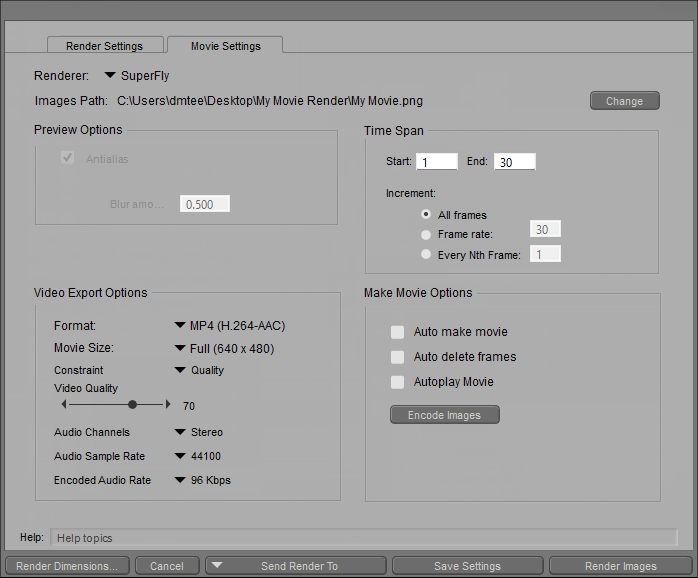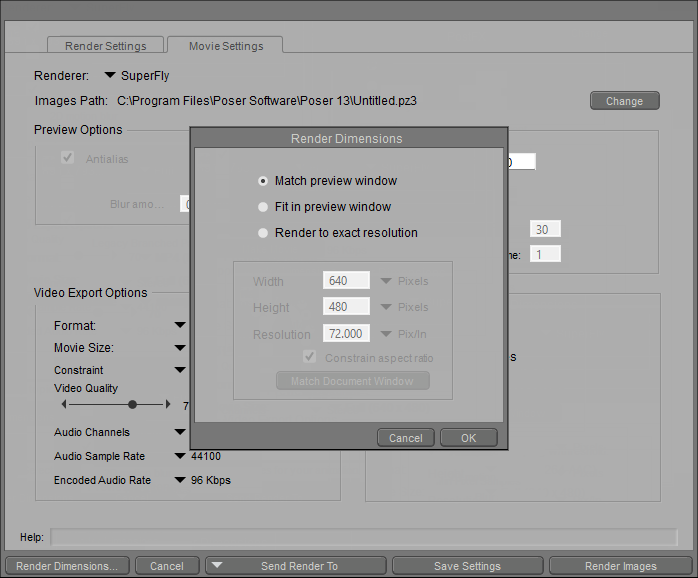Rendering Animations
You can access the Movie Settings window by selecting Animation > Make Movie. This window can also be accessed via the Render Settings dialog. The Movie Settings window appears as follows.
Initially, the Make Movie dialog renders individual image files for each frame in your animation. You can specify a folder and filename for your image sequence. The image sequence will be named based on the filename, followed by an underscore and a four-digit number (example: My Movie_0001.png).
After the image sequence is complete, you can create a movie file based on the additional movie settings described below.

The Movie Settings dialog.
To use the Movie Settings window:
- Select which renderer you wish to use for your animation using the Renderer pull-down menu. Your options are the FireFly, Sketch, Preview or SuperFly render engines.
- Specify an Image Path. Click the Change button and specify the file folder and filename for your saved images.
- Under the Preview Options section, check the appropriate checkboxes when available:
- Antialias: Antialiasing is available with the Preview render engine, to improve the quality of images in draft preview renders.
- 2D Motion Blur: This option provides realistic 2D motion blurring effects to images and animations rendered with the FireFly or Preview render engines. Use the Blur Amount value to customize the results of this effect.
- Specify your Time Span settings:
- Range: Enter the start and end frame numbers for the portion of your animation that you wish to render in the Start and End boxes. This feature is useful if you wish to save a subset of the total animation. For example, if you create a 60-frame animation, you could opt to save a 15-frame movie beginning 35 frames into the total animation.
- Increment: Click the appropriate Increment radio button to specify how many frames to render in your movie output. Your choices are as follows:
- All Frames: Clicking the All Frames button will render all frames in the specified range, as defined by the movie’s frame rate.
- Frame Rate: Click the Frame Rate (number of frames per second) radio button to use the movie’s current output frame rate (as opposed to the actual frame rate of the Poser keyframe data) or specify your own. Enter the desired frame rate in the box, if you wish to specify a frame rate other than the rate defined for the document, lower numbers result in choppier animations but take less time to render. Higher numbers give smoother animations but require longer rendering times and take up more room on your hard drive. Please refer to for a listing of common frame rates.
- Every Nth Frame: Clicking this radio button allows you to render fewer frames, for fast preview purposes. For example, rendering every 2nd frame takes half the time as rendering every frame, and so on. Specify your desired “N” value in the box.
- In the Video Export Options section, choose the desired video Format using the Format pull-down menu. Your available options (for Mac and Windows, unless as noted) are:
- MP4 (H.264-AAC): The most commonly used format for distributing media online or by disc.
- iPhone: Three different resolutions, including iPhone Movie (480x320), iPhone 4 Movie (960x640) and iPhone 5 Movie (1136x640)
- iPad: Two different resolutions, including iPad Movie (1024x768) and iPad HD Movie (1280 x 1024), to save your files in M4V format.
H.264, iPhone, and iPad options may not be available on earlier versions of Windows.
- Android Movie: Two different resolutions, including Android Movie (480x360) and Android HD Movie (1280x1024).
- AVI (Windows Only): Three options are available in Windows for AVI format. Choose AVI (MJPEG) to produce an AVI file of any dimension, using a higher amount of compression (for streaming); choose AVI (DV) to produce a 720x480 pixel DV-quality AVI file. Choose AVI (Uncompressed) to produce an AVI file of any dimension, which will not be compressed.
AVI DV format will produce a 720 x 480 pixel AVI file, regardless of your render settings. If your project render settings are not set to the same aspect ratio, the movie will be stretched to fit within the 720x480 movie file.
- WMV/ASF (Windows Only): Three options appear for WMV/ASF format, for varying compression options: Medium Quality, High Quality, and Uncompressed.
WMV/ASF options use Windows Media Audio 10 and Windows Media Video 9.
WMV output presets are also available in Windows Vista, and Poser will write out valid WMV files if you choose the WMV/ASF preset. While Media Player for Windows Vista does not support WMV files, you will be able to play them in any third-party media player that runs under Windows Vista and has WMV support.
- PNG HD Movie (1280x1024) (Mac Only): Creates a high-quality movie with lossless compression.
- DV-NTSC (640x480) (Mac Only): Creates an NTSC-compatible video with 4:3 aspect ratio.
- MOV - (H.264-AAC) (Mac Only): Creates a compressed video suitable for streaming online.
- MOV - (pixlet-AAC) (Mac Only): Creates a high quality highly compressed video; however Apple Pixlet format is only playable on Macintosh systems running MacOS 10.3 or later.
- In the Video Export Options section, choose your desired Movie Size. This offers quick access to four different render scale options, based on the render dimensions specified in the Render Dimensions dialog: Full Size, Half Size, Quarter Size, and Preview Size. To access the Render Dimensions dialog, click the Render Dimensions button, described below.
As an example of what Movie Size presets do, assume that you specify custom render dimensions of 1200 pixels width and 1600 pixels height, which will render a portrait-style render.
Full Size will render a 1200 x 1600 pixel image.
Half Size will render a 600 x 800 pixel image.
Quarter Size will render a 300 x 400 pixel image.
Preview Size will render the full scene, based on the size of your preview window.
If you specify a custom image size that renders to portrait or landscape resolutions, a production frame will highlight the area that will appear in your render.The production frame is determined by the aspect ratio resulting from the output width and height. You can set the production frame to be visible in the Document’s scene preview area, by selecting Display > Production Frame from the menu bar.
- The Constraint option in the Video Export Options section allows you to specify video quality by a Quality value (a percentage value adjustable from 1 to 100%) or by Bitrate (adjustable from 1000 to 10000 bits per second).
- Select an Audio Channels option, either Mono or Stereo.
- Choose an Audio Sample Rate. Choices are 44100 or 48000.
- Choose an Encoded Audio Rate. Choices are 96, 128, 160 or 192 Kbps.
- In the Make Movie Options section, choose additional options as follows:
- Auto make movie: Automatically creates the movie file after Poser completes rendering the image sequence. When unchecked, you will need to click the Make Movie button to manually create the movie file.
- Auto delete frames: When checked, deletes the image file sequence after the movie is created.
- Autoplay Movie: When checked, automatically plays the movie after it is created.
- Encode Images: After rendering individual image files, you can click this button to turn the images into a movie file. The movie will be created based on all of the frames found in the location specified in Step 2, and will be compiled in the same order as the filenames. Gaps are allowed in the numbering. You can generate the image frames in any order, and in as many passes as you like, but the images must all be the same dimensions and file type, or they will be skipped.
- The buttons at the bottom of the Movie Settings dialog are as follows:
- Click the Render Dimensions button in the lower left corner of the Movie Settings tab to open the Render Dimensions dialog. Enter the desired dimensions for your movie. For more information about this dialog, see Render Dimensions.
- Click Cancel to exit the Movie Settings dialog without saving your changes.
- Click Send Render To to send your FireFly or SuperFly render to the Queue Manager.
- Click Save Settings to save your render settings to the Movie Settings dialog. Note that you will still need to save the Poser scene, with File > Save.
- Click Render Images to render an image sequence to the image path specified in step 2. If the path is not valid, Poser will prompt you to verify and change your image path.

Setting Render Dimensions.